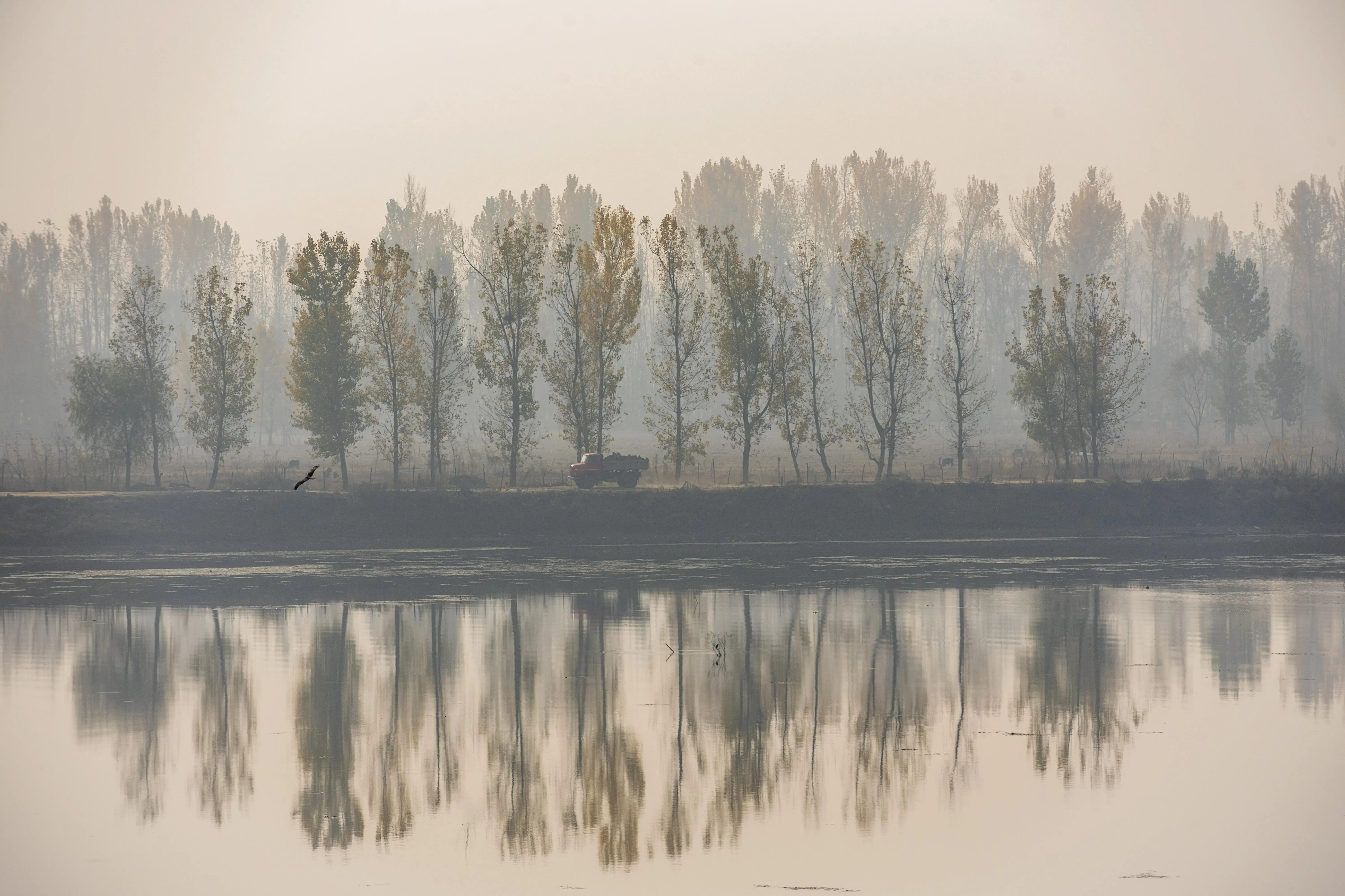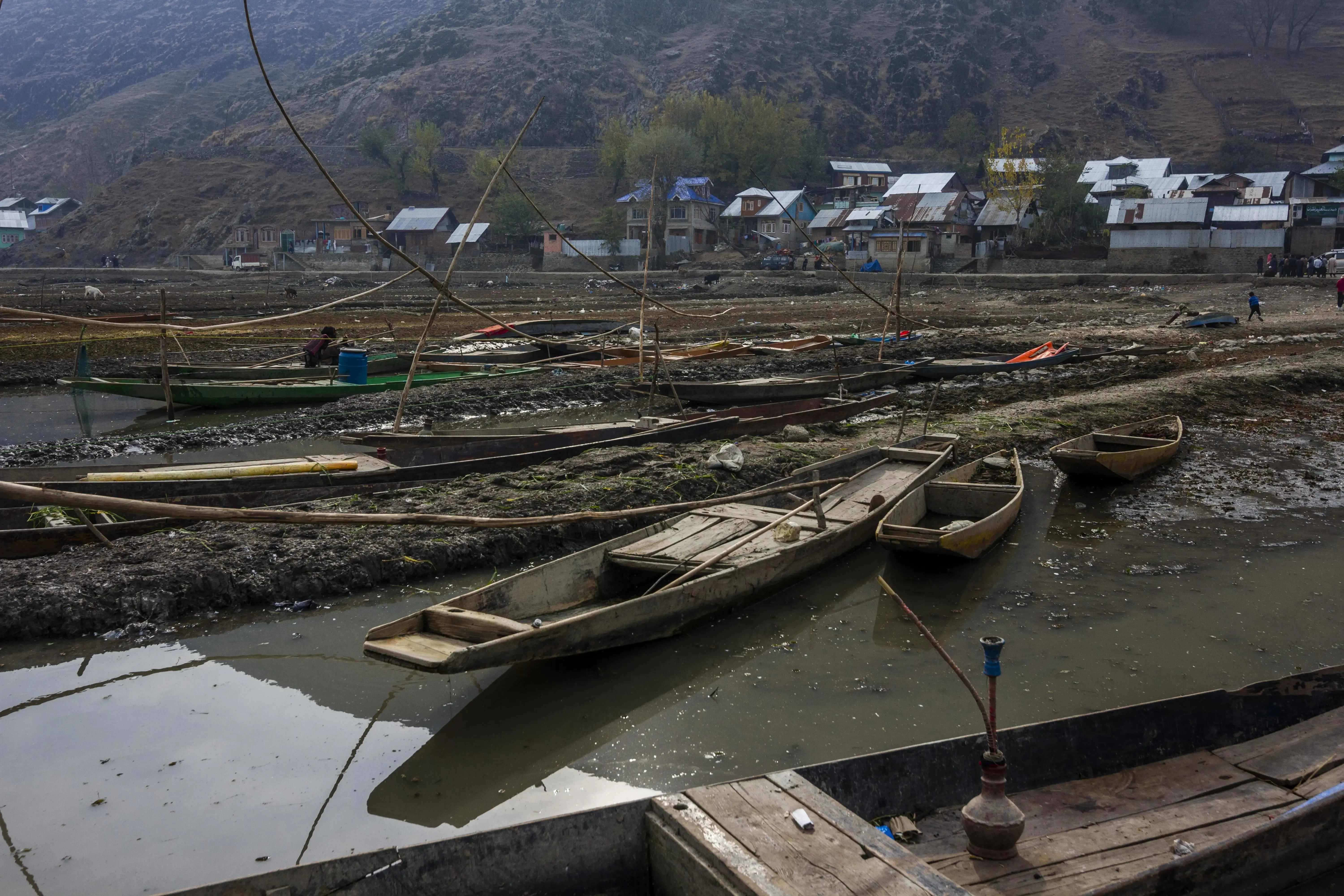
Situated in north Kashmir, the Wular Lake has been gulping sewage, industrial, and horticulture waste, replete with fertilizer and pesticide, for decades.
As we drive through the outskirts of Srinagar city, the summer capital of Jammu and Kashmir—the conflict-ridden Muslim-majority region in India—and enter Ganderbal district, environmental filmmaker Jalal Jeelani comments, “All of this used to be agricultural land, but villagers are selling more and more of it, and people are building huge houses and settling down. Whatever they earn, they spend on building the houses.” Not only Ganderbal, but even the neighboring districts of Pulwama and Baramulla are coming closer to Srinagar, he said.
It’s early November in 2022 and winter is on its way. Apart from getting a little foggy, there is a nip in the air. Most leaves on the trees have fallen and the remaining have hints of red, yellow and orange—colors of harud or fall. Locals have started wearing the pheran—the traditional woolen gown worn in Kashmir—gearing up for Chillai Kalan, the harshest 40 days of winter in the valley.

As a nonprofit journalism organization, we depend on your support to fund more than 170 reporting projects every year on critical global and local issues. Donate any amount today to become a Pulitzer Center Champion and receive exclusive benefits!
On our way to Wular Lake—the second largest freshwater lake in Asia—in northern Kashmir, a series of houses, shops, rice fields, and Indian army bunkers constantly dot the landscape. Jeelani comments once again: “What you see behind the fields is the University of Kashmir. It has been built over wetlands.”
Famously called “paradise” or “heaven” on earth by medieval poets and emperors, the Kashmir Valley has several wetlands located in the floodplain of Jhelum river which fulfill different purposes such as decreasing flooding, recharging groundwater, and providing habitat for wildlife and migratory birds.
Wular, 17-square-mile in area, is one of them. It was designated as a “wetland of international importance” in 1990. Said to be key to the overall ecology of the Kashmir Valley, it was the saving grace during the 2014 floods that had devastated the region. About 88% of the lake’s water comes from the Jhelum River, which rises from the springs in southern Kashmir, is fed by tributaries along the way, drains into the Wular, and emerges once through a channel in the border town of Uri before entering Pakistan.
But, over the last few years, the lake has turned into a waste dump, and has been gulping sewage, industrial and horticulture waste, replete with fertilizer and pesticide. Shrouded by encroachments, paddy fields, and willow plantations, the lake and surrounding marshes are mere shadows of their former selves.

It has also shrunk in size over the decades. In a 2022 study, researchers used data from the Indian Space Research Organization and found that its open water area had reduced by about one-quarter between 2008 and 2019. As we crossed the Jhelum river and Manasbal Lake—18 miles from Srinagar—and made stops to ask locals for directions since the GPS had stopped working, Jeelani pointed out several agricultural fields and said: “This all used to be Wular.”
The lake also suffers from eutrophication—a condition occurring when an influx of sediment and nutrients leads to rapid growth of algae and aquatic vegetation in the water body and causes oxygen depletion—which impairs the water quality and leads to loss of aquatic species and subaquatic vegetation.
Indian researchers used water samples and data from Landsat satellites to assess the biological health of Wular and found that about 57 percent of the lake had become eutrophic in 2018. Conversion of forests into urban areas has been a major driver of this change, since it delivered heavy sediment and nutrient loads into the lake, along with untreated sewage.
In the 2017 award-winning film “Saving the Saviour,” Jeelani followed the then 15-year-old ragpicker Bilal Ahmed Dar, who picked up trash in Wular to make a living. One could see the amount and variety of trash he scouted from the water, ranging from plastic water bottles to discarded shoes and clothes. Hailing from village Lahawarpora in Bandipora, Dar had quit school after his father’s death to support his mother and two sisters. But soon afterwards he was recognized for his efforts and got a job with the local corporation after Prime Minister Narendra Modi mentioned him on his radio show.

As we inch closer, there are no concrete roads and only mud tracks that lead to the lake. Soon the Wular reveals itself. There are hardly any locals in sight, since there are just a handful of fishing villages settled around the lake. Only trucks making rounds to dispose of the dredged silt from the lake.
In 2020, the Wular Conservation and Management Authority (WUCMA) began dredging in the lake in hopes of reviving it. It is a process involving underwater excavation of sediments and debris from the bottom of the lakes and other water bodies. But they managed to raise water levels in an area less than 2 sq miles, out of 17 sq miles, in the last three years. Moreover operations have been confined to the eastern part of the vast lake.
Multiple studies have established the negative impact of dredging on aquatic life. Several fishers that this reporter spoke to are already reporting further decrease in catch. Environmentalists also allege that ill-managed dredging is hindering movement of waterbirds. From over a hundred thousand birds that usually graced the wetlands, only a few hundred were spotted last season, they said.
However, Reyaz Ahmad Shah, the forest officer with WUCMA, claimed that ever since that eastern part of the lake was dredged, it has enhanced the fish, flora and fauna of the lake. Earlier this year, Showkat Ahmad, another employee at this office, managed to capture the Smew, a globally vulnerable long-tailed duck, on camera, which he claimed was spotted in Kashmir after over eight decades.
As we drove over the silted path on the lake to reach a lighthouse, we saw the vast willow infestations in the middle of the water body. These plantations are not native to the ecosystem but were planted by the government to meet the demand for firewood. “They act as a weed and it negatively impacts the lake’s ecosystem,” said Shah, and is another reason for why the lake has shrunk.


Hence for the Wular to survive, the authorities say that the willows need to go. Last year, they said 120,000 willow trees were cut to restore about 1.7 square miles of “critically” silted up area. Another 70,000 trees would be felled soon, the WUCMA told the High Court of Jammu and Kashmir and Ladakh last year.
However, these willow plantations are the backbone of the cricket bat manufacturing industry in Kashmir. The sport is hugely popular in South Asia, and local manufacturers said that the demand for Kashmir willow bat increased after it was introduced during a tournament in Dubai in 2021. The industry in Kashmir employs more than 10,000 people and manufactures over a million bats per year.



But the most hit by the crisis in the Wular is its community of over 9,000 fisher families living in 32 villages around the lake. They are hard to reach due to lack of properly constructed roads. However, when this reporter visited Zurimanz village of Bandipora district, fishers said they spend more on fishing than what they earn from the meager catch. The majority of them, in huge debt, are turning to cities for seasonal gigs, while also dealing with the impact of the political conflict, militancy, curfew and shutdowns.
In its glory days, Wular produced up to 5,000 tons of fish of 11 different species, and four metric tons of water chestnuts annually. Till a decade ago, the fishers used to catch about 20 to 30 pounds of fish, but now they don’t get more than 6 to 8 pounds. Mohammad Yaqoob, 40, a fisherman in Zurimanz, remembers the Wular lake of his childhood. “It was absolutely pristine and the boat went all the way till the shore, it wasn’t silted and full of garbage as it is now,” he said.
However, in the last few years, he has noticed the increase in aquatic vegetation and sewage in the waters which has lent a grayish-black color to it. There are only two types of fish found in the lake now. If not 11, earlier there were at least 5 to 6 breeds of fish they would catch. “We hardly catch 2 to 3 pounds of fish on some days, which fetches us 350 rupees (4$) a day,” he said. “During the lean period, in the winters, there is hardly any catch. Hence, a lot of people have quit this job.”

Usually, the more popular Dal Lake in Srinagar gets the attention of the media, since it is in the heart of the capital and extremely popular with the tourists and honeymooners. It has a highly commercial ecosystem with “shikara” boats, house boats, a floating farmers’ market and a thriving community of residents living on its backwaters, and is also surrounded by historical terraced gardens—laid out in the 16th and 17th century by Mughal emperors—which are lined with fountains and planted with a variety of flowers, herbs, and aromatic plants.
Weeds, silt and untreated sewage has been increasingly choking this lake too. Researchers in Srinagar found that land conversion due to urban development had worsened its water quality and reduced its size. Between 1980 and 2018, it shrunk in area by 25 percent. Even a lay person gets a sense of this encroachment and its shrinking size from nearby Shankaracharya Hill, where the famous Shiva temple is situated and overlooks the waterbody.



Overall, the impact of climate change can be seen on ground in Kashmir. The canals and streams branching out of Jhelum, which irrigates the paddy fields in the region, are now dry. Kashmir recorded 80% less rainfall than normal last year, which led to an increase in temperatures. Untimely snowfall in April has also damaged apple plantations and many farmers have been chopping off their orchards. The region, which saw devastating floods in 2014, has been experiencing heat waves recently, and government officials acknowledge that residents are facing a drinking water shortage.
However, in Wular, the government is planning to develop tourism activity around the area and encourage ecotourism. They recently built a boardwalk beside the lake that offers a view of Mount Harmukh, and are planning to build a road around the lake, like the Boulevard around Dal Lake, where locals and tourists often come for leisurely drives and evening hangouts. They also expect these developments to generate new avenues for the livelihood of the locals who have only depended on fishing.
“Until you don’t invite people in the conservation process, change will not be possible. Till the time you don’t build ecotourism around it, Wular will be neglected and isolated,” said Jeelani. Whether it helps Wular or further adds to the crisis is yet to be seen.









